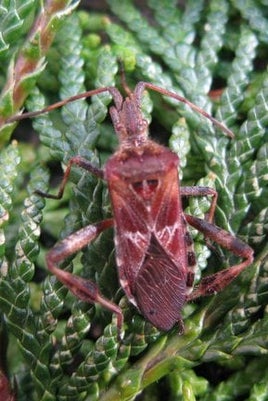
Quick facts
Common name - Western conifer seed bug
Scientific - nameLeptoglossus occidentalis
Distribution - First reported in Britain in 2007, established in England and Wales
Food - Sap feeder on pines, Pinus and some other conifers
What is western conifer seed bug?
The western conifer seed bug Leptoglossus occidentalis, is a large reddish-brown squashbug that can reach 2 cm (¾ in) in length. There is a white zigzag line across the centre of its wings and it has leaf-like expansions on its hind legs. It feeds on the of pines and some other conifers, especially on the seed cones. The bug is to North America and was first reported in Europe (Italy) in the late 1990s, it reached Britain in 2007 and is becoming widespread in England and Wales.
The adult insect can fly and they are attracted at night to bright lights. They also have a tendency to seek shelter in buildings as the weather turns cooler in the autumn. During winter they can become active indoors and are sometimes found on windowsills.
This species is sometimes confused with another species of true bug which may be of more concern, the Brown Marmorated Stink Bug (BMSB). Western conifer seed bug is larger with noticeably flared hind legs. BMSB is not yet known to be established in the UK.
The western conifer seed bug is a sap sucking true bug in the family Coreidae (the squash bugs), there are 11 species found in Britain. They all feed on plant sap but none damage garden plants. More information on these bugs can be found from British Bugs.
Symptoms
Western conifer seed bug feeds on the of pines, Pinus and some other conifers, especially from the seed cones. It can affect the viability of seeds but it is unlikely to affect the health or growth of garden plants. The bug can affect seed production and so it may become an issue for nurseries.
Management
Western conifer seed bug is unlikely to affect the health and vigour of garden trees and so management measures in the home garden are not necessary. If found indoors the bugs can be placed outside.
Biology
Western conifer seed bug overwinters as adults in sheltered places such as under and in buildings.
In spring the adults emerge and females lay up to 80 eggs on the foliage of conifers. After two weeks the eggs hatch and the nymphs feed on needles and tender cones. There are five stages of development (nymphal instars) and they become adults in mid to late summer. Larger nymphs and adults feed almost exclusively on developing seeds and cones.

